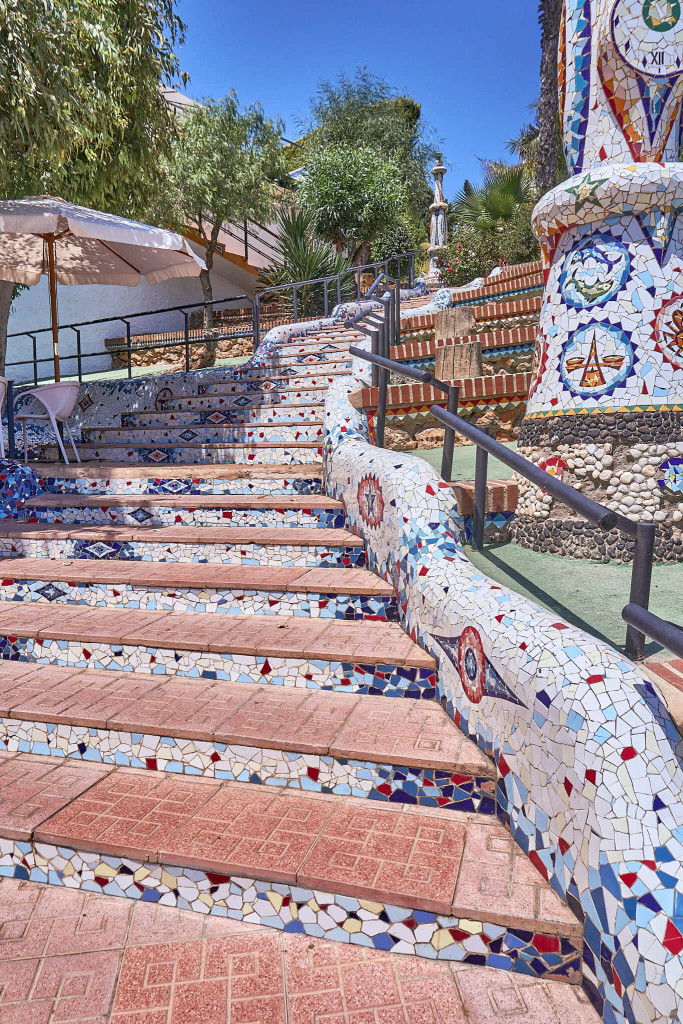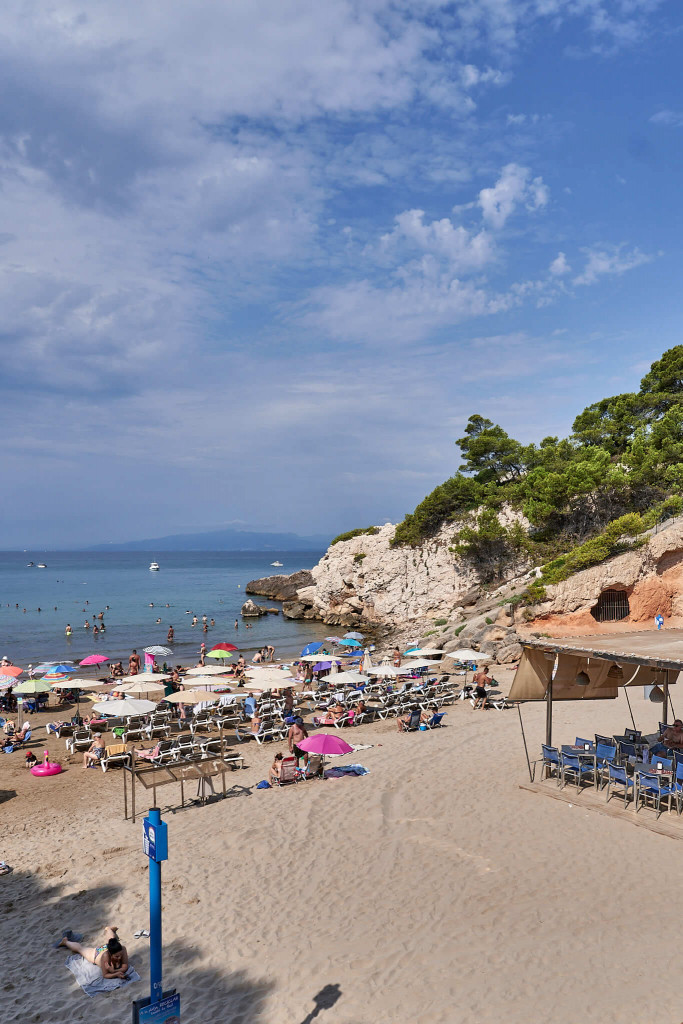Our extensive two-week plan for the Spanish Mediterranean Coast offers a delightful exploration of iconic small towns and villages, as well as the breathtaking nature along the coast of Spain. Tailored for those who prefer a more leisurely pace, this itinerary is especially suitable for travelers with kids. Many classic highlights are not part of the itinerary, the itinerary reveals the charm of Spanish architecture in serene villages and the inviting culture of coastal cities.
Where we stayed
The first week, we stayed at Vera Playa Club Hotel near Almeria – our third visit to this delightful establishment. The hotel boasts a spacious, well-shaped outdoor pool and a smaller indoor pool. Guests can engage in activities like chess and minigolf at no additional cost. What we particularly appreciate about the resort are two factors: its restaurant terrace, perfectly situated by the beach, and a direct pathway from the hotel grounds to the seaside. This arrangement allowed us to relish our meals with a sea view and catch breathtaking sunsets.
Vera Playa Club Hotel holds the distinction of being the first naturist hotel in Spain. While nudity is mandatory in the pool area throughout the day, the clothing-optional policy applies to the rest of the premises. Our stay there offered a unique holiday experience in an authentic oasis. Despite the unconventional setting, we appreciate the hotel for its prime location, convenience, family-friendly amenities, and gourmet dining options.
During the second week, our accommodation was at Hotel Cara Font near Salou. Recently renovated, the hotel sits conveniently by a public beach, catering to families with kids seeking a typical beach holiday. In high season, regular buses facilitate easy travel to the city of Salou. The hotel is situated approximately 4 kilometres away from the main beach of Salou, accessible via a segment of the scenic hiking trail, Camí de Ronda.
Summary of the itinerary
The itinerary of the Road Trip along the Spanish Mediterranean Coast is as follow:
- 1st Day: Arrival
- 2ed Day: Beach of Vera Playa
- 3rd Day: Mojácar Pueblo in Andalucía
- 4th Day: Alcazaba of Almeria
- 5th Day: Playa de los Cocedores, Aguilas
- 6th Day: Vera Playa beach
- 7th Day: Drove to Cala Font near Salou
- 8th Day: Camí de Ronda (from Hotel Cala Font to Punta del Cap de Salou)
- 9th Day: Salou
- 10th Day: Sitges
- 11th Day: Tarragona
- 12th Day: Camí de Ronda (from Hotel Cala Font to the beach of Salou)
- 13th Day: Montblanc, Salou at night
- 14th Day: Drive back to Frankfurt
The attractions we explored were all within an hour’s drive, leaving us with ample time for relaxation. After our excursions, we made sure not to miss the opportunity to take a refreshing dip in the sea or chill our in the pool.
1st & 2ed Day
During check-in, we were provided with pool towels. As the afternoon was already well underway, we seized the opportunity to unwind by the pool.
The following day, we opted for a leisurely time by the pool or a refreshing swim in the sea. Surprisingly, the Mediterranean Sea boasted a temperature of 28°C, even warmer than the pool! Due to the high waves, we took extra precautions while entering the water, and the vigilant lifeguard patrolled the beach.
3rd Day: Mojácar Pueblo in Andalucía
Mojácar Pueblo, a classic whitewashed village near our hotel, stands out as one of Almeria’s most enchanting spots. Despite its small size, Mojácar Pueblo is brimming with delightful surprises. Mudéjar architecture, winding narrow streets, picturesque corners, and whitewashed houses provide the perfect subjects for my photography.



4th Day: Alcazaba of Almería
Almeria is approximately an hour’s drive away. The Alcazaba of Almería stands as the largest fortress constructed by the Arabs in Spain, a fascinating relic of the country’s rich history. Despite following Google navigation, we couldn’t find the designated parking, so we parked on the street near the palace and close to a garbage dumping place.
The recently refurbished Alcazaba of Almería consists of three sections: living quarters and baths, palace buildings, and the remnants of a castle constructed by Ferdinand and Isabella after their conquest of the city in 1489.


5th Day: Playa de los Cocedores, Aguilas
On our way to Águilas, we made a pit stop at Playa de los Cocedores, a renowned beach known for its picturesque coves. The beach, nestled in a small half-round bay, proved to be an ideal spot for capturing memorable photographs.
Águilas, situated on Costa Cálida, is a charming port city that caught my attention with its distinctive black-and-white striped lighthouse, a windmill perched atop a hill, graffiti-adorned stairways, and the castle-fortress of San Juan de Águilas, which adds to the city’s uniqueness. At a waterfront eatery, we tried crispy fried eggplant fingers. Despite not being a fan of eggplant due to its vegetal bitterness, the sweet crispy coating and golden brown hue of this dish pleasantly satisfied my appetite.



6th Day: Vera Playa beach
With one more day left, we decided to spend our final day lounging on the beach and by the hotel pool. The hotel provided evening entertainment featuring live music and dancing performances that conclude at midnight. As a result, during the early morning, only a handful of guests joined us for a swim. We enjoyed some leisure time in the pool, and after a post-lunch siesta in the late afternoon when most guests flocked to the pool, we ventured into the sea. Even far from the shore, the water remained shallow, allowing us to stand shoulder-deep on the sandy bottom. Undoubtedly, this stands out as one of the finest beaches along the Spanish Mediterranean Coast.
7th Day: Drove to Cala Font near Salou
It took us approximately six hours to drive to Salou. However, considering the lunch break, our journey extended throughout the day. Upon our arrival at Hotel Cala Font, we faced the challenge of not being able to park in front of the hotel for unloading luggage and check-in. Consequently, we had to drive to a nearby free parking area.
Subsequently, we observed that tourists could park almost anywhere along the streets or in some unpaved parking areas in the surrounding forests.
8th Day: Camí de Ronda (from Hotel Cala Font to Punta del Cap de Salou)
The seaside path, Camí de Ronda, near Salou spans a length of 6 kilometres. It runs along the beaches and coves in a less touristy area. We initially headed towards Cap Salou but decided to turn back shortly before reaching it. The weather was sultry, with an air temperature of 34°C. Unfortunately, we hadn’t brought enough water or worn suitable shoes for the hike, underestimating the trail’s challenges. The best course of action was to cool down and refresh in the sea.
Hence, we quickly made our way to jump into the water or relax on the beach!



9th Day: Salou
In the early morning, Salou was peaceful, but by lunchtime, the beach buzzed with activity. The promenade, adorned with a palm tree alley, statues, and fountains, looked charming. We strolled through the center, exploring aimlessly and seeking refuge from the heat in air-conditioned souvenir shops.
By lunchtime, despite many restaurants being open, they had only a few guests. Although eateries with sea views had enticing menus, the lack of air-conditioning made outdoor seating less appealing in the scorching heat.
A few streets away from the waterfront, we found a KFC with air-conditioning. It was crowded, and we had to wait quite a while to get our food.


10th Day: Sitges
Sitges is an ideal day trip from Barcelona along the Spanish Mediterranean coast. Unlike the typical whitewashed Spanish villages, Sitges stands out for its vibrant and inclusive LGBT-friendly community. Even before entering the old town, the views along the picturesque coastline captured my attention. The charming old quarter boasts cobbled alleyways adorned with several palaces.
The Church of San Bartolome and Santa Tecla (Església de Sant Bartomeu i Santa Tecla) is a prominent landmark visible from a distance and can be easily reached along the beach. From the old town, we strolled to Ermita de la Trinitat de Sitges, a small chapel on the hill, before making our way back to the historic quarter.
11th Day: Tarragona
The historic quarter of Tarragona remains largely untouched, showcasing narrow alleys, the Roman Amphitheatre, and a Cathedral situated at the highest point of the capital. This city, steeped in thousands of years of civilization, never fails to surprise.
On that scorching hot day, we took on a lengthy walk from the centre to the Balcony to the Mediterranean, a splendid viewpoint that opens up to the sea over the beach. By lunchtime, the heat became unbearable, prompting us to seek refuge in a Japanese restaurant along the main street La Rambla Nova. Fortunately, it was air-conditioned and offered an all-you-can-eat Sushi lunch buffet at 13.50 Euros per person!



12th Day: Camí de Ronda (from Hotel Cala Font to the beach of Salou)
According to the map, the route from Cala Font to Salou seemed like an easier walk. This time we made sure to have sufficient water and wore our hiking shoes. As we perspired, the breathtaking views of the beaches and coves made the effort worthwhile. Camí de Ronda stands out as one of the finest hiking trails along the Spanish Mediterranean Coast.
13th Day: Montblanc, Salou at night
Montblanc stands out as one of Cataluña’s exceptionally well-preserved medieval walled towns. Although small, it boasts numerous Romanesque and Gothic monuments worth exploring. During the scorching Spanish summer, strolling through the historic streets provides a delightful escape from the intense sunshine and heat waves.
During the preceding two evenings, our attempts to secure parking in Salou were futile. As the sun-drenched beach enthusiasts emerged from the water, the streets, restaurants, and shops swelled with activity. Even tourists from nearby villages flocked to partake in the evening buzz. Consequently, on the third evening, we took the local bus, smoothly transporting us to the heart of Salou.


14th Day: Drive back to Frankfurt
During our return journey to Germany, we opted to stay overnight at Ibis. The following day, we made a brief stop in Nancy, France, enjoying a quick lunch in the city center before continuing our trip back to Frankfurt.
Spanish Mediterranean Coast Travel tips
There are numerous beautiful beaches along the Mediterranean Coast of Spain. If possible, consider exploring different beaches during your holiday, as they offer unique charm and are often less crowded.
For those without a car, the local bus company, BusPlana, provides regular services from Ribarroja to Bellaterra along Costa Dorada. Information booths, located in various places like downtown Salou and Cala Font, offer maps and ticket sales. Always check the local timetable, as the website might not have the latest information.




It looks like you’ve seen A LOT in just 14 days, that must have been a really nice raod trip. The itinerary is really helpful, thanks for sharing!
Love this blog post! It is perfect for those who enjoy beaches and water. I like Mojacar Pueblo with white washed houses – so typical in many white villages in Spain. The Alcazaba of Almeria sounds great with its moorish architecture and baths. The all-you-can-eat sushi lunch is the best! 🙂
Spain is on my bucket list. You covered a lot of ground in 2 weeks despite the heat. I’d need AC in order to survive.
Of the places you are listing, I’ve been only to Sitges which is definitely a small gem. But I’ve heard great things about Almeria so I’m planning on going there on one of my next trips to Spain. The Mediterranean coast is definitely one of a kind and there are so many grand places to see.